
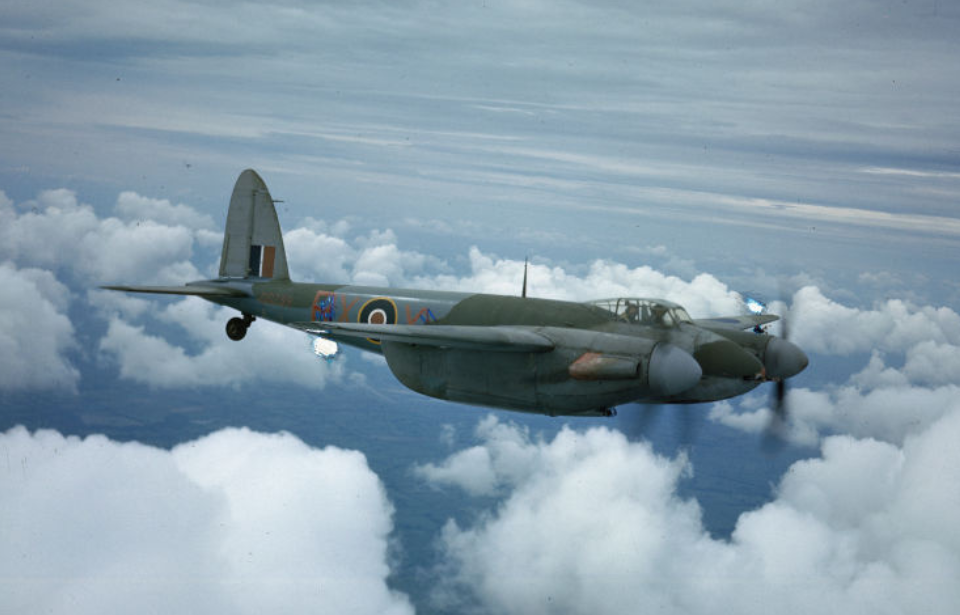
The de Havilland Mosquito was a British twin-engine, multirole combat aircraft that served with the Royal Air Force (RAF) and other Allied air forces during the Second World War. It was constructed primarily of wood, earning it the nickname, “Wooden Wonder.” The Mosquito was first introduced in 1941, and the final operational units were retired in 1963.
Development of the de Havilland Mosquito
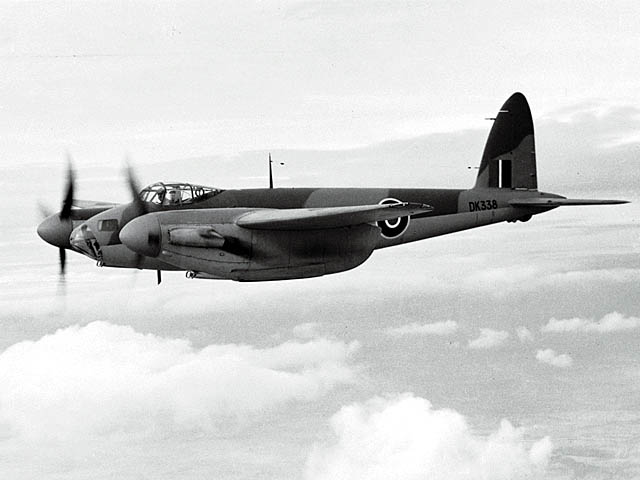
In the 1930s, de Havilland gained a reputation for its high-speed aircraft, notably the DH.88 Comet. The company also pioneered composite wood construction with the DH.91 Albatross. Wooden aircraft showed superiority, making them lighter and easier to manufacture.
On September 8, 1936, the British Air Ministry released requirements for a new bomber, including the need for a twin-engine, with the ability to carry 3,000 pounds of bombs and hit a top speed of 275 MPH. Examples produced to fill this role include the Avro Manchester and Handley Page Halifax.
Geoffrey de Havilland believed his company could design a bomber that exceeded the specifications set out by the Air Ministry.
The first element of the new aircraft was that the primary material used would be wood. On July 7, 1938, de Havilland wrote to Air Marshal Wilfrid Freeman to argue that, in times of war, aluminum and steel may not be available in the required amounts, while wood likely would. The strength-to-weight ratio of wood, argued de Havilland, was equal to or even better than any metal alternatives, and it was practical.
Freeman’s response was one of disagreement. This, however, didn’t stop de Havilland and the company continued to work on the concept. The design was still too radical for the Air Ministry when World War II broke out. However, after a full mock-up was presented to the RAF, the de Havilland DH.98 Mosquito gained official backing.
de Havilland maintained the company and its workers “could produce a twin-engine bomber which would have a performance so outstanding that little defensive equipment would be needed.” The Mosquito performed outstandingly during the war and became regarded as the most versatile warplane ever constructed.
de Havilland Mosquito specs.
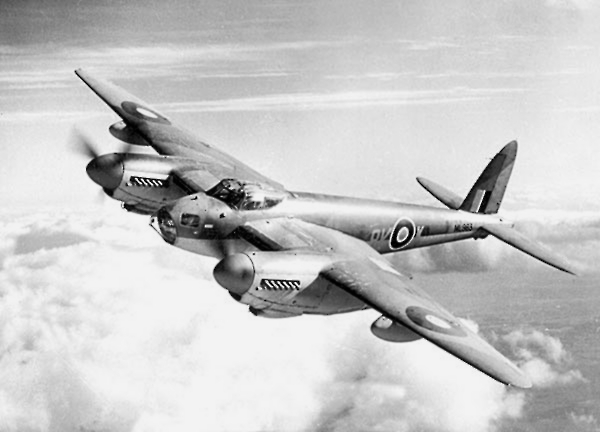
The de Havilland Mosquito had an overall sleek design, characterized by high wings further ahead of the fuselage, a cockpit above the nose and a cone effect tapering the airframe to the tail. This was best described by F/O Frank Ruskell of No. 109 Squadron RAF:
“The first thing that struck one about the Mosquito was the beauty of line of the fuselage, tailplane, fin and engine cowlings. They all went together and made a lovely aeroplane. The cockpit cover also had a sweet line, and the undercarriage’s simplicity and the treaded tyres set the whole thing off. The aircraft set on the ground looking pert and eager, and it was easy to become fond of, which was no means true of all aeroplanes.”
The Mosquito was powered by two Rolls-Royce Merlin engines. These V-12 piston aero engines, with three-bladed, constant-speed propellers, were also used on other British Warbirds, including the Avro Lancaster, Hawker Hurricane and Supermarine Spitfire, and allowed the aircraft to reach a maximum speed of 415 MPH at 28,000 feet.
The Mosquito also carried a formidable armament. Located in the nose of the aircraft were eight gun ports – four belonging to 7.7 mm Browning machine guns and four for 20 mm Hispano cannons. The Mosquito could also carry up to 4,000 pounds of bombs in a single bomb bay.
Service during the Second World War
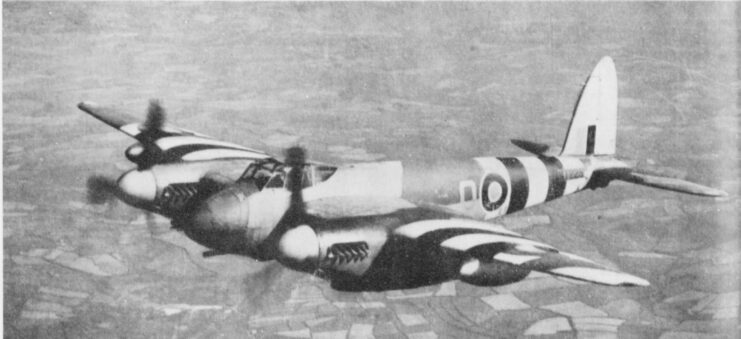
The de Havilland Mosquito entered service on November 15, 1941 and quickly became known as a highly versatile aircraft. It took on various roles, including medium bomber, fighter-bomber, night fighter, maritime strike aircraft and photo-reconnaissance. During the war, it excelled at each of these roles.
The first production Mosquito became part of the No. 1 Photographic Reconnaissance Unit, and the first mission took place on September 19, 1941.
Soon after taking on more aggressive roles as a bomber, the Mosquito became feared by the Germans. Lecturing German aircraft manufacturers, Hermann Göring said of the aircraft:
“In 1940, I could at least fly as far as Glasgow in most of my aircraft, but not now! It makes me furious when I see the Mosquito. I turn green and yellow with envy. The British, who can afford aluminum better than we can, knock together a beautiful wooden aircraft that every piano factory over there is building, and they give it a speed which they have now increased yet again.”
He continued to chastise the manufacturer, saying, “What do you make of that? There is nothing the British do not have. They have the geniuses and we have the nincompoops. After the war is over, I’m going to buy a British radio set – then at least I’ll own something that has always worked!”
The Mosquito took part in many famed operations. For instance, on the 10th anniversary of the German government coming into power, they took out the Berlin Broadcasting Station while Göring was making a speech, taking him off the air. Another attack later that afternoon did the same for a speech being made by Joseph Goebbels. The Mosquito not only devastated German targets, it also devastated their pride.
Oslo Mosquito Raid
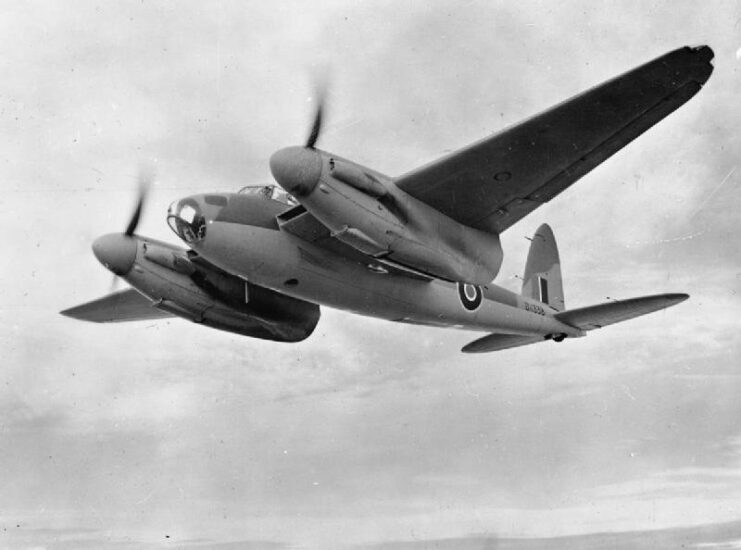
On September 25, 1942, four de Havilland Mosquitos attacked the Victoria Terrasse building in Oslo, Norway – the Gestapo headquarters. Flying less than 100 feet at low levels, the aircraft, armed with 500-pound bombs with delayed fuses, departed Scotland via the North Sea.
Despite flying at low levels, two Fock-Wulf Fw 190s intercepted them. One Mosquito was forced to land by one of the attacking enemy fighters, while the other German aircraft had to land after clipping a tree with its wing. The three remaining Mosquitos dropped their bombs onto the headquarters. The building, however, wasn’t destroyed. One bomb didn’t explode, while the others detonated after they’d crashed through the other wall and outside of the structure.
While the air raid failed in its objectives, it marked the first time the RAF made the existence of the Mosquito known, and it signified what would come from the new aircraft.
Operation Jericho
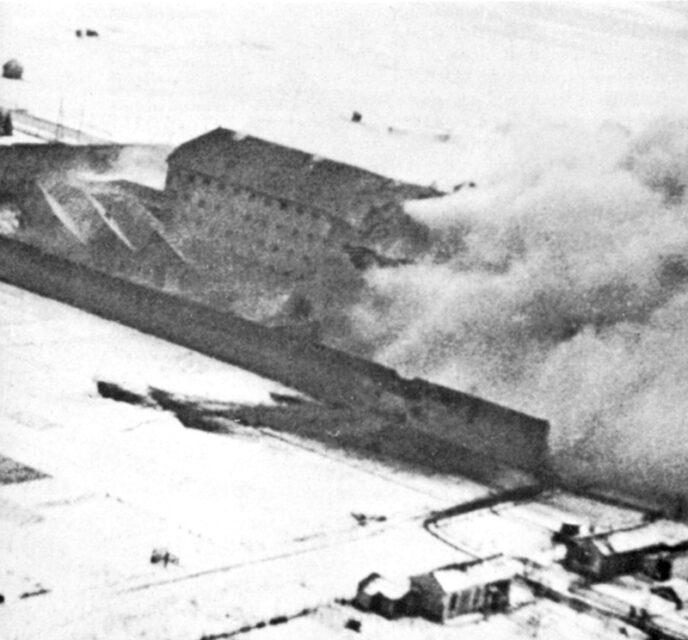
On February 18, 1944, Mosquitos and Hawker Typhoons bombed Amiens Prison in German-occupied France. The attacking force flew at low levels, making holes in the prison walls and killing German guards by destroying their barracks.
The aircraft also helped prisoners escape to the French Resistance fighters waiting outside. Of the 832 held there, 102 were killed by the bombings, while 74 were wounded and another 255 escaped. Of that total, however, 182 were soon recaptured.
Two Mosquitos and a Typhoon were shot down during the operation, while a second Typhoon was lost at sea. That being said, it showed the abilities of the Mosquito to perform very precise attacks – and do so in a quick and effective manner.
By the end of WWII, 7,781 Mosquitos had been produced. “Mossies,” as they were sometimes called, hadn’t only shown their strength with the RAF, but other air forces within the British Empire, including Canada, Australia, New Zealand and South Africa. They also enjoyed service with the US Army Air Forces and 15 other nations, including France, Israel and the Soviet Union.